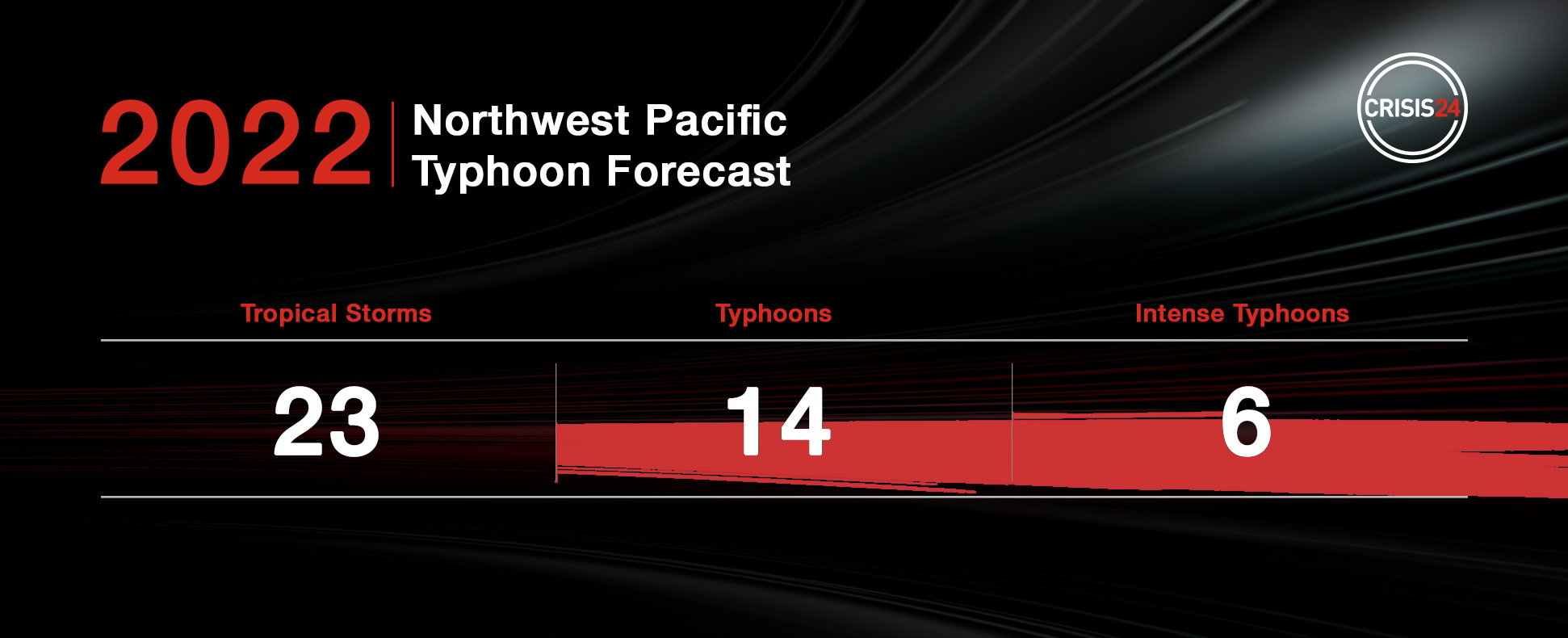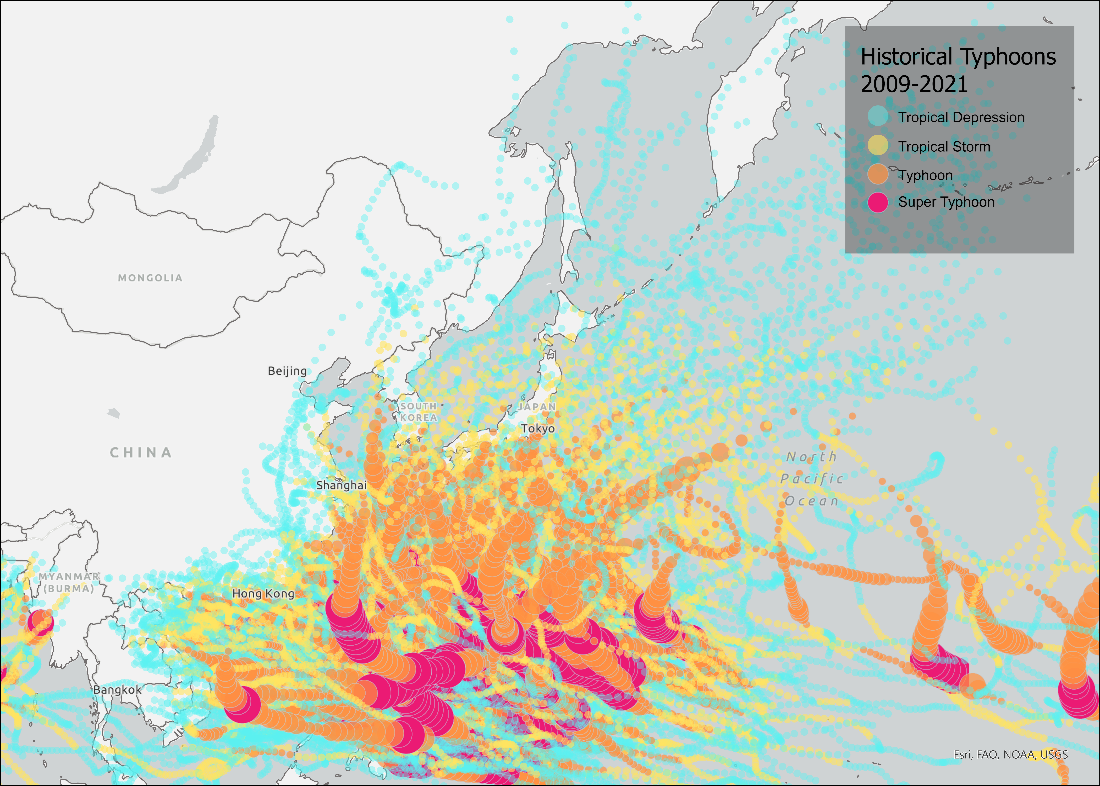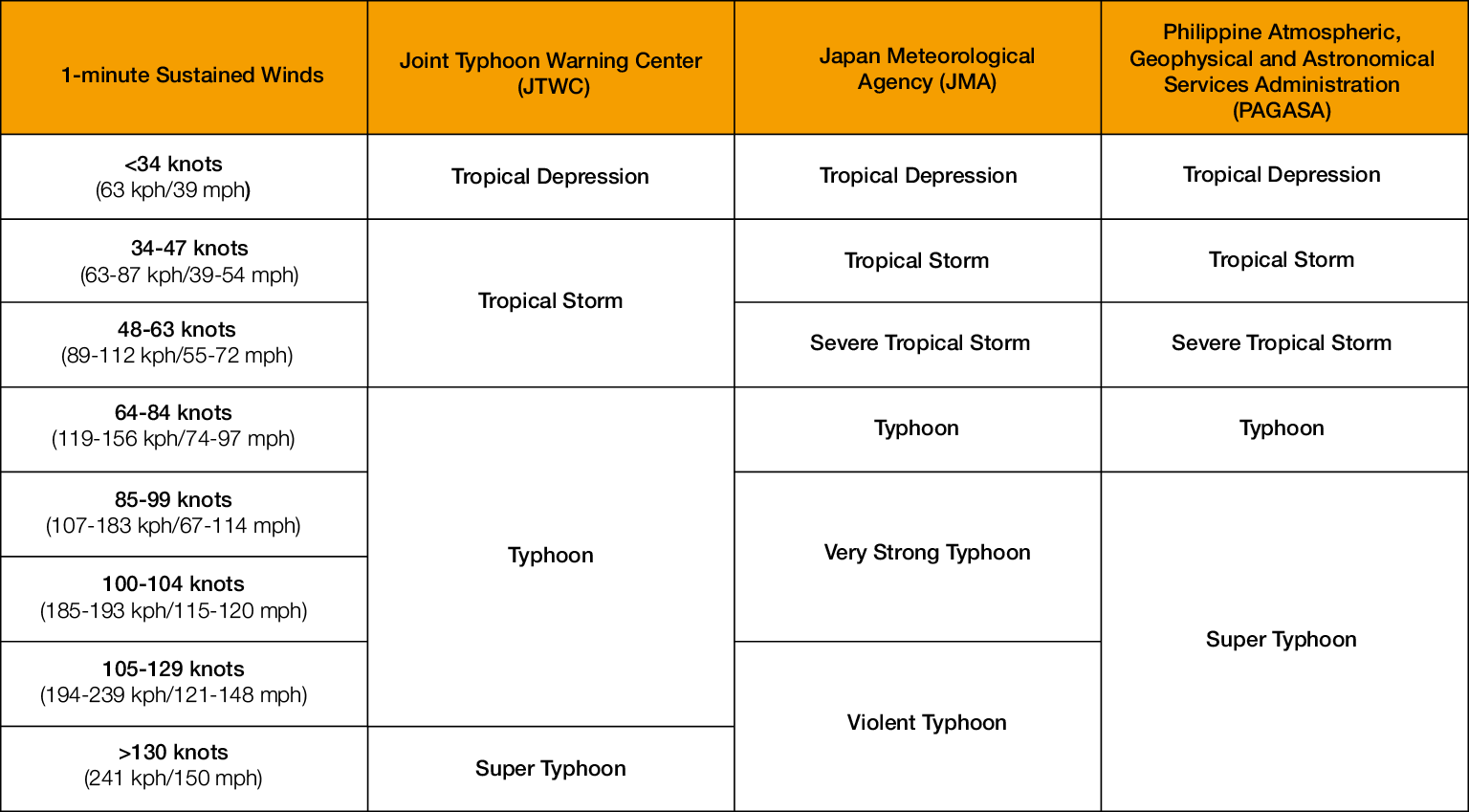Forecast
The Northwest Pacific typhoon season runs throughout the year, predominantly between May and October. Tropical Storm Risk (TSR) has forecast 35 percent below normal Northwest Pacific typhoon activity in 2022 with above-average confidence. La Nina conditions are forecast to strengthen slightly and persist through October 2022, leading to stronger-than-average trade winds over the Northwest Pacific basin and creating less favorable conditions for storms to develop and intensify.
Forecasters consider a combination of climatic indicators, including sea surface temperatures and the El Niño-Southern Oscillation (ENSO) cycle, and compare these to historical trends to formulate a probabilistic assessment of the likely level of tropical cyclone activity for the upcoming season. Warmer sea surface temperatures provide conditions more favorable for tropical systems to form. Forecasters are unable to provide early accurate predictions of precisely where typhoons and other storm systems are likely to make landfall each season as the track of each particular system is determined by the specific weather conditions present during its formation and development; however, some estimates on the number of storms in a relatively wide geographical area can be made based on the predicted level of activity during the season. There is always a degree of uncertainty with any forecast, and any significant change in climatic conditions could alter the level of activity in each basin. The real impact of the tropical systems will be determined by their tracks and where they hit. Anyone living or traveling within the region over the next few months should keep up to date with local weather reports and be prepared for the possibility of being impacted by tropical systems.
2022 Northwest Pacific Typhoon Forecast

Storm systems vary greatly in intensity and track and have the potential to impact anywhere from Brunei northwards, across East Asia and the rest of northern and central Southeast Asia, into southeastern Russia. Storm systems generally weaken upon landfall, making coastal areas the most at risk. However, some systems can continue to track inland with varying intensities and bring adverse conditions to places far from the coast.
Paths of Previous Typhoons and Named Storms in the Northwestern Pacific Basin 2009-2021

Storm systems have the potential to have a major impact on areas they pass over, posing a threat to life and causing hundreds of billions of dollars of damage each year. The primary hazard from tropical systems is flooding caused by both storm surge (an abnormal rise in coastal or riverine waters generated by storm winds) and periods of heavy rainfall associated with the storms. Strong winds can also cause property damage, whip up dangerous flying debris as the storm passes, and generate rough seas that pose a threat to mariners and coastal residents. Tornadoes can also occur when storms make landfall.
Typhoons are usually classified according to their sustained wind speed. Meteorological agencies from various countries, including the Philippines and Japan, utilize slightly different classification systems. The Joint Typhoon Warning Center (JTWC) uses a tropical system’s 1-minute sustained wind speed (see Image 2) to classify typhoons. This is comparable to the Saffir–Simpson hurricane wind scale utilized in the Atlantic as well as central and eastern Pacific basins.
While the sustained wind speed can be used to gauge the expected level of wind damage the typhoon may cause, it does not consider other environmental hazards such as storm surges, rainfall, and tornadoes. The intensity of a storm is not the only factor in determining the likely extent of its impact, with other factors also having a major influence. For example, a slow-moving storm, regardless of its intensity, has the potential to produce lingering showers over a particular region, which may be more impactful than a higher-intensity storm that passes rapidly through an area. Additionally, the relative vulnerability and preparedness of the location struck by the storm can greatly affect the level of damage and disruptions caused. For instance, due to limited resources and constraints in assistance reaching the population in need, some remote Pacific islands may be more heavily impacted by relatively minor storms than coastal areas of mainland Asia. If an island only has one airport or port and these are damaged during the storm, it restricts their ability to receive aid.
Typhoon Classification

Saffir-Simpson Hurricane Wind Scale

Impact of Typhoons
The most visible consequences of typhoons are often seen in the path of destruction they leave in their wake. Flooding, strong winds, and rough seas brought by storm systems can cause fatalities and injuries as well as damage to homes, businesses, and agricultural land. Damage to infrastructure can also be substantial with widespread power outages, contaminated water supplies, major transport disruptions, and interruptions to internet services and mobile communications. Health and emergency services may also be overstretched by the multitude of demands for their services. Transport closures and major supply chain disruptions can lead to a lack of availability of goods and services in the immediate aftermath of a storm.
The road to recovery following the impact of a typhoon can be long and expensive. It can take months or years for areas to be restored to something resembling their previous state, and there is no guarantee that another storm system will not strike while the recovery is ongoing. Damage to airports, ports, rail lines, roads, and other transport infrastructure can lead to difficulties in receiving aid or other goods required in the aftermath of a typhoon. There are many other secondary long-term ramifications that can be attributed to a typhoon, such as a drop in tourism, poor agricultural conditions for future crops, and even long-term mental and physical health impacts on the local community.
Preparation Measures for Organizations with Operations in Areas with Typhoon Risk
Regardless of the forecast levels of typhoon activity, anyone living, operating, traveling, or with business interests in areas that have the potential to be exposed to tropical systems are strongly advised to take measures to prepare for the upcoming typhoon season. Below are some simple tips on ensuring preparedness to be in a better position for the eventuality of being affected by typhoons:
- Assess your risk: Conduct a thorough hazard and vulnerability assessment to better understand your potential exposure to storm systems. Consider possible worst-case scenarios and the potential direct and indirect impacts these could have on your business, home, or premises. Try to gain a good understanding of what hazards are likely to have the largest impact and take any practical steps available to mitigate the level of risk.
- Review insurance policies: Ensure any business, home, or travel insurance policies cover any damage, cancellations, or loss of income that may be incurred following a typhoon. While some schemes may cover wind damage sustained during typhoon activity, supplementary protection policies could be required for derived events like flooding, landslides, or storm surges.
- Stay informed: Monitor local weather agencies and local media for updates on storm systems. As a storm system approaches, agencies generally provide regular updates on the forecast track and intensity of the storm, so be sure to check regularly to ascertain the likely level of impact on your particular area of operations. Sign up for travel security alerts, emergency management agency alerts, and any other available community alerts to ensure you are informed of any weather or local authority advisories regarding approaching storm systems.
- Have a plan in place: Create, review, or update any existing contingency, business continuity, or home emergency plans to ensure they are relevant and proportionate to the potential threat posed by typhoons. Check that all emergency contact numbers are up to date and, where possible, identify evacuation routes in case the need arises.
- Have supplies ready to go: Gather an emergency kit or go-bag in case of the need to either shelter in place or evacuate. Essential items include (but are not limited to) water, non-perishable food, torches, first-aid kit, batteries, radio, medicines, sanitary products, cash, ID, and paper copies of any important documents, as internet access may not be possible in the aftermath of a storm. Be sure to regularly check that items in your emergency kit are working and in date.
Recommendations for Mitigating Risk During and After a Typhoon
Meteorological agencies are often able to monitor the formation of typhoons and other storm systems and gain a good understanding of their likely track and intensity as they develop. Some notice is usually given to potentially affected communities before a typhoon strikes. If there is enough notice and the option is available to self-evacuate before the arrival of a storm system, then it is advisable to do so at the earliest opportunity. Authorities can close airports and ports as the storm closes in, meaning the opportunity to leave may disappear at short notice. Various factors can mean it is not always possible to vacate the path of the storm, such as family or business commitments to an area or a late change in track, or increase in the intensity of a storm system. If you do find yourself in the position of having to ride out the storm, follow the advice below:
- Final preparations: If there is time to do so, take measures to strengthen your home or premises against the possible impacts of the storm. Board up windows, secure any loose structures or items, and clear gutters to enable water to flow through them. Make sure electronic devices are fully charged in preparation for possible power outages. Take the opportunity to familiarize yourself with emergency or evacuation plans in case they need to be activated.
- Follow the advice of authorities: Continue to stay up to date with weather and media updates for information regarding the storm and any local authority advisories. Heed any evacuation orders issued and do not return until authorities have deemed it safe to do so.
- Hide from the wind, run from the water: As the storm passes, you should shelter in a designated shelter or interior room of your home away from any windows. Only leave if flooding occurs in your location, in which case move as safely as possible to higher ground. Do not attempt to drive or walk through floodwaters – turn around, don’t drown. Only call the emergency services if you are in life-threatening danger, as they are likely to be extremely stretched during this period.
- Post-typhoon: Beware of continuing hazards after a typhoon has passed. Only leave your place of shelter once authorities have confirmed it is safe to do so. A brief lull in the wind could be mistaken for the storm being over when in fact, it is the eye of the storm passing through, and intense winds would soon return. Be careful and wear protective clothing during clean-up. Do not touch any electrical equipment if it has come into contact with water or if you are in standing water. Damp conditions can also provide a breeding ground for mold and water-borne diseases. Save phone calls for emergencies only. Phone systems could be down or overwhelmed so use SMS or social media to inform people you are safe and to check the safety of others.
Crisis24 provides actionable risk intelligence, risk management planning, training, crisis response expertise to keep your organization ahead of emerging risks. Learn about Crisis24’s integrated approach to risk management.
Author(s)
Elizabeth Yin
Intelligence Analyst I
Elizabeth Yin joined the Crisis24 Weather and Environment Team as an Intelligence Analyst in 2021 and holds a Bachelor’s degree in Marine Geoscience, Geology, and Geophysics from the University of...
Learn More


